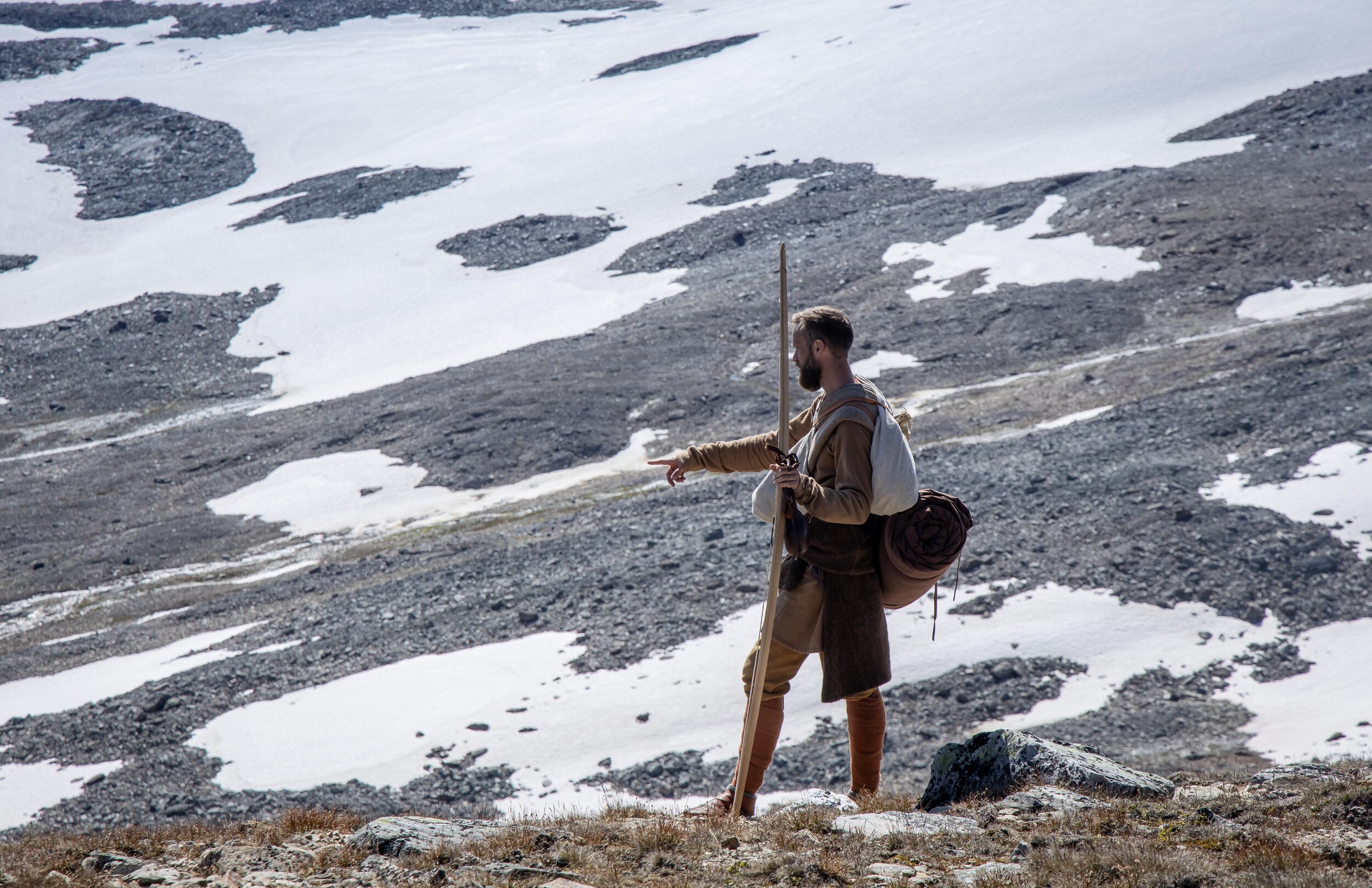
Crossing Lendbreen
Discovering the ice’s secrets
“IT’S HARD TO FORGET ABOUT THE PAST WHEN YOU'RE WALKING ON IT.”
AN ARCHAEOLOGICAL HOTSPOT
As temperatures are rising, and glaciers are melting, archaeological treasures are awoken from their long slumber and reaching the surface. They have been hidden beneath the ice for millennia and now, at certain sites, the melting glaciers are revealing their secrets. One such sites is the Lendbreen ice patch in Breheimen. Since archaeologist started investigating the area in 2011, an astonishing number of artefacts have been discovered. Some of these finds have received a lot of international attention, like the well-preserved ski, the now famous Lendbreen tunic and a spear with its intact wooden shaft are amongst the finest examples. Some of the finds are unique, with no other examples known, like a simple shoe made from skin with the hair left on for better grip on slippery ground. The finds are mainly dated in the period from 300-1500 AD.
PLANNING AND PREPARATIONS
We went through as much of the documentation material as we could find to get a good sense of where to go. The map below, put together by the Secrets of the ice team, gave us a lot of useful information in order to prepare our journey. It mainly shows the area covered by the ice patches and an area covered by lichen. The area between ice and lichen was until recently covered by the glacier. It also showed us some features in the landscape that would be easy to navigate by, like the two lakes and the two mountain tops. The organic finds are believed to move as the ice in the glacier moves, but the heavy iron finds like horseshoes are not so mobile. Who could tell what we might have encountered? The cairns are not moving and do their function as way pointers. After studying the map for quite a while, we got a good notion of where the route was and how to follow it.
The next step was to figure out where to start and where to finish, and what the difference in altitude was. It turns out that the distance from the valley down by Skjåk to the summer farms by Neto is not that big. It was for this reason that we decided to make these our points of departure and arrival. The climb on the other hand would be pretty hard core. We would start at about 400 meters above sea level and climb up to almost 2000 meters. In addition to that, it seemed to be mainly rocks, big and small, piled one upon another. We realized then and there that this was going to be something else compared to the hikes we normally do.
We decided to pack light, as light as possible. It was hard to know how far we would get on the first day, but we were confident that we were able to make the whole hike in two days. The original plan was to push hard the first day, get over the top, and make camp on the other side when vegetation started to appear again, so we would be safely and cosily below the tree line. As you will notice later, this did not go completely according to plan. But hey! such is the nature of these adventures. Luckily, we knew that the risk to have to camp in a place without firewood was big, so we planned for a cold camp. A fire would just be a bonus.
All of us packed warm wool clothes, including mittens and caps, to be prepared for wind, rain and even snow (you got to love Norway in August). Each of us had one blanket and one reindeer pelt for sleeping. We brought one tarp to share and a backpack with food. Additionally, some things like an axe, rope, a water bottle and a first aid kit are a mandatory addition to any historical hiker’s gear. There’s no reason bringing weapons while doing hikes like this from a modern point of view, but considering authenticity (as we always do) it does make sense. This lead us to bringing a bow and arrows.
Hiking without historically accurate Hazelnut cookies was never an option.
AMONG ROCKS, ICE AND CLOUDS
After all was said and done, we had a route, we had the equipment in place, and we were as motivated as one can get. As we can deduct from the finds, the route was used when the mountains were covered by snow, probably during early winter and/or spring, so you might be wondering why we went in August. Full disclosure, mainly because it corresponded with our vacations (silly but true) and the fact that we did not have enough skies for all of us (maybe next time?). The hike up to the glacier can be divided into three parts. Steep climb in woodlands, following a path, a quite flat marshy plateau with bushes and a steep climb with a little of vegetation in the start but eventually rocks, rocks and guess what, more rocks. We were well prepared and all ready to go, but what lay in store for us none could have known.
The first day showed us that this was not going to be a walk in the proverbial park, or literally for that matter. After a tough ascend we reached the lake right below the glacier by the end of the day. We were quite exhausted, and it was starting to get dark, so we decided to make camp there. This seemed like the wisest option as we did not know how much further we would have to walk to find a camp site on the other side of the mountain top. The full scope of our ambition became clear. But by doing it this way we did create some time to walk around the ice patches without all our stuff which was quite a lot fun. It made us all very aware of the overwhelming beauty of the surroundings, but at the same time it gave is an opportunity to reflect on why the glacier is melting in the first place. Although the archaeological treasures are amazing, there is a certain sadness lurking behind the reason for their appearance.
Setting up camp was a challenge, since the area consisted of three things only: rocks, ice and water. We luckily found a shallow hole in the ground where we re-arranged the stones to make a flat surface (if anyone ever needs instructions on how to make glacier rock mattress, be sure to call Hands on History). We put the tarp over it, securing the corners with rocks on the one end and elevating it in the other side with two walking stick we picked up earlier that day. Even though the skies were clear and we were not expecting rain, putting up the tarp is a way to keep the warmth. We expected the temperature to drop below zero during the night.
We finished the day with a bath in the glacier lake, a light meal and a walk around the area. The landscape, the sunset light and the mist made the whole thing other-worldly. Falling asleep was not difficult even though the ground was as hard as it can get. We slept close to keep warm, with all our clothes on. A cap and extra socks are under such circumstances very important.
Tip: Want to make your talks more exciting? Add a glacier to the background!
We had some trouble finding a good route down the steep mountain sides, which made us think about making our way with horses. That must have been quite something. After an intense descent, we ended up following an idyllic stream flowing down the mountain side. Once down in the lichen-covered area, we rested and filled up out water bottles before heading in the direction of our final destination. The end of the journey was both magical and tough. We pushed ourselves to the limit, making our way down with a determination that was bolstered and nurtured by every step whilst fighting exhaustion lingering in the back of our minds. But in the end, we descended from the mists of time into the modern world below. We made it, Lendbreen was ours!
It was a truly astonishing and magical journey full of unforgettable moments and discoveries. This experience has allowed us to be reminded of why we do what we do. Our determination of bringing the past back to the present is now reinforced with even more passion than before. Because by traversing by the steps of those who came before, we shape who we are and will become. Mighty Lendbreen might be melting, but if we become conscious of what is going on in the mountains of Norway, we may yet discover more Secrets of the Ice and learn what they have to say about ourselves.
The next morning when we woke up, the camp was covered with frost. The sunrise was as beautiful as the sunset. The views were breath-taking. It is good to be alive. After breakfast in bed we packed our things and started the second part of our journey. Crossing the glacier was a highlight. We could see the cairns on the other side, while wild reindeers further up on the ice patch were wondering what a bunch of Vikings were doing on their peaceful glacier. The crampons we brought came in handy while walking on the sloping ice.
After traversing the icy sides, we reached the highest point between the two peaks and looked down into the next valley, a sight of truly epic proportions. There is something magical about standing there and realizing that you are but one pair in an unnumbered series of eyes that have admired the same view. Although we felt ecstatic to have made it this far, we knew that the journey was not over yet.
Oh no, it was not.
Secrets of the ice as inspiration!
Check out the amazing secrets of the ice project which inspired us to traverse the Glacier in the first place. It’s a unique, sad, amazing, exciting, and all together fascinating undertaking.









